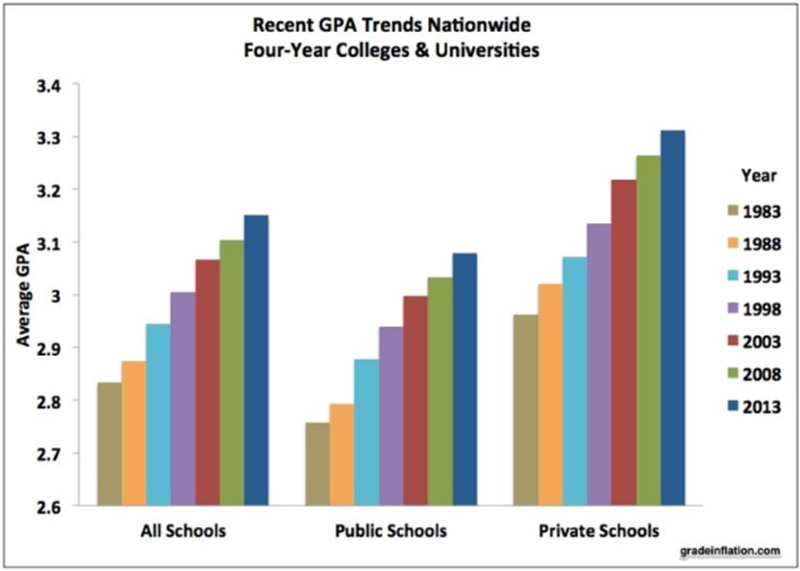
Grade Point Average (GPA) is an important measurement of student performance used by nearly all universities in the United States. It is often rated on a 4-point scale of 4 being most positive, 3 fairly positive, 2 neutral and 1 being fairly negative and 0 being most negative. An A is equivalent to a maximum score of 4 on the 0 to 4 scale.
The average GPA for college-bound students averages 3.0. In most selective universities, including Ivy League schools, the average GPA of students that passed their admissions track is normally well above 4.0
No | School | Location | Average GPA |
1 | Harvard University | Cambridge, MA | 4.18 |
2 | Duke University | Durham, NC | 4.15 |
3 | Stanford University | Stanford, CA | 4.11 |
4 | Princeton University | Princeton, NJ | 4.00 |
5 | California Institute of Technology | Pasadena, CA | 3.97 |
6 | Massachusetts Institute of Technology | Cambridge, MA | 3.91 |
7 | Yale University | New Haven, CT | 3.89 |
8 | University of Pennsylvania | Philadelphia, PA | 3.89 |
9 | Brown University | Providence, RI | 3.87 |
10 | Pomona College | Claremont, CA | 3.86 |
In reference to seeking admission in a programme of Ivy League schools and other reputable universities, one can attest that academic standards are normally set higher. Many of the students who get directed to these schools are Cream of the crop and they post good grades to their academic achievements and score a GPA of more than 4. 0. This is because most of these schools factor in the weighted GPAs and this scale gives some credit to honors, AP or IB classes. For instance, an A is valued at 5 in an AP course or section where the grading scale is different from others. It often provides four options for each question instead of the typical multiple choice of 0, A, B, C, and D. 0. The total GPAs of students who had been accepted in Ivy League schools typically hover around the 4. 1 and 4. 5, which not only showcases academic achievements and passing complicated courses in many areas. Admissions committees at these quality universities seek to enroll students who have the tendency to really put in efforts in their academics meaning that if you got slightly lower GPA in a more compact and difficult classes, then the probability for you to be admitted for a university is higher that if you got slightly higher GPA in more flexible and easy classes.
Furthermore, the tip of getting in the top 10% of the scale of their high school class is also crucial to the application. These schools do require GPA and academic rigor, but they also have holistic application review that takes into account other factors such as SAT and ACT scores, community service, position held, essay, and recommendation. For example, a survey on the admitted students established that students in Harvard University enjoy an average Gross Average Percentage (GPA) of 4. 18 (weighted), at Princeton it is about 3 The number of students enrolled in four-year institutions is higher in some minorities, although the numbers are relatively small. An unweighted mean of 9 such realizations and a higher weighted mean, which at Yale is approximately 4. 14 (weighted). To enhance your chances of getting admissions in Ivy League schools, then make sure you take harder courses, work hard and ensure you get good grades in all subjects, ensure that you have been improving on your GPAs, participate actively in extracurricular activities and leadership responsibilities. Admission offices look for talents who are also academically inclined and potential leaders who have passion in what they take.
Grade inflation refers to a situation where students are awarded higher grades for work they would normally have been given lower grades. This leads to inflation of the average performance scores for students which are actually not an improvement on the knowledge and academic accomplishments in class. Grade inflation can occur for several reasons, including:
According to a recent ACT report, the average GPA for high school students increased from 3.17 in 2010 to 3.36 in 2021. Similarly, the average GPA at four-year colleges and universities rose from 2.83 in 1983 to 3.15 in 2013. Around the year 2000, an 'A' became the most common grade awarded. At Harvard, the average GPA has notably risen from 2.8 in 1966 to 3.8 in 2022—a full point increase. This trend of grade inflation raises concerns about how employers can distinguish top applicants when high grades are so prevalent.

The GPA increased over time
It is important to note that while schools are a good indicator, they might use different grading systems or different weights to certain grades, such as honors/AP classes. This variance can affect your GPA score and its comparisons with other students and academic performance scores. Understanding how GPA and the calculation thereof works can go a long way in helping you make practical goals thereby ensuring that one makes sound decisions concerning his/her academic strategy. I used the specific UA strategies that have been identified to increase a student’s likelihood of achieving his or her academic and professional goals by striving for a high GPA.